Step-by-step instructions for growing the “Golden Nugget” tomato and its benefits
The varieties of tomato crops never cease to amaze with their diversity, which can amaze even the most experienced vegetable grower. The original shapes of the fruits, different flavors and exquisite colors indicate the constant development of selection.
The Golden Nugget tomato variety is notable for its ability to be grown at home. In addition, the variety is high-yielding, disease-resistant, and is distinguished by simple agricultural technology and unusual yellow cream tomatoes of excellent taste.
Characteristics and description of the variety
The golden nugget belongs to the cherry tomato variety, not an f1 hybrid, so planting material can be selected independently. Seeds retain their parental properties in subsequent generations.
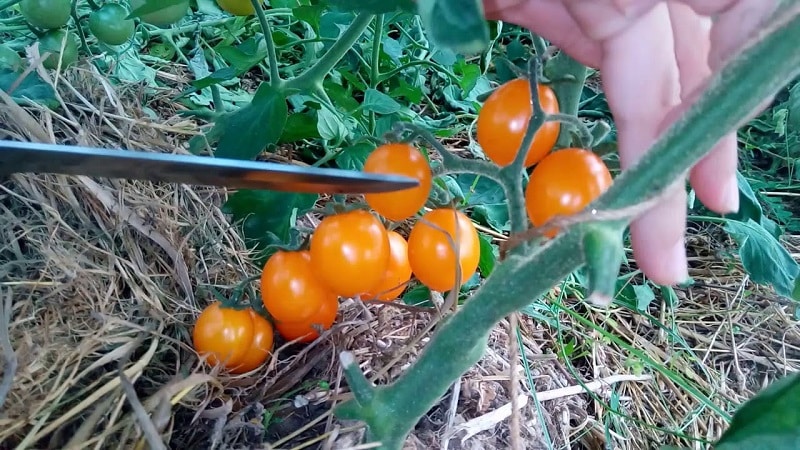
Distinctive features
The species is determinate, height 1.2-1.5 m, the stem is strong, as is the root system. Forms 8-9 brushes, increasing a large amount of green mass. The leaves are light green, slightly elongated. 8-10 fruits are formed on each brush.
Mid-season variety, from the moment of sowing the seeds until full ripening 110-115 days pass.
Productivity is high, from 1 sq. m are collected up to 8 kg, subject to planting 3-4 seedlings per 1 sq. m. Fruiting is extended.
Recommended for cultivation in open ground and in greenhouse conditions. It has good resistance to diseases of the nightshade family, but is susceptible to late blight.
Tall crop, requires mandatory staking and pinching. To get more fruits, the plant is grown in 2 stems.
Fruit characteristics
The average fruit weight is 25-50 g, the shape is round, slightly elongated, the fruits look like plums. Yellow color, reminiscent of gold. The skin is thin, but quite durable and does not crack even during heat treatment. The pulp is juicy, there are 2-3 seed chambers. The taste is sweet with barely noticeable sourness.
Vegetables have a high content of lycopene, beta-carotene and protein substances, but are hypoallergenic, which makes them suitable for baby food and dietary dishes.
The purpose of ripe vegetables is universal: Look great in salads, suitable for sandwiches and canapés. For winter preparations, they are used in a wide variety of ways: from whole-fruit canning to preparing tomato products. Can be dried, frozen and dried.
Vegetables hold up well long-term transportation and subject to long-term storage.
The photo shows Golden Nugget tomatoes:
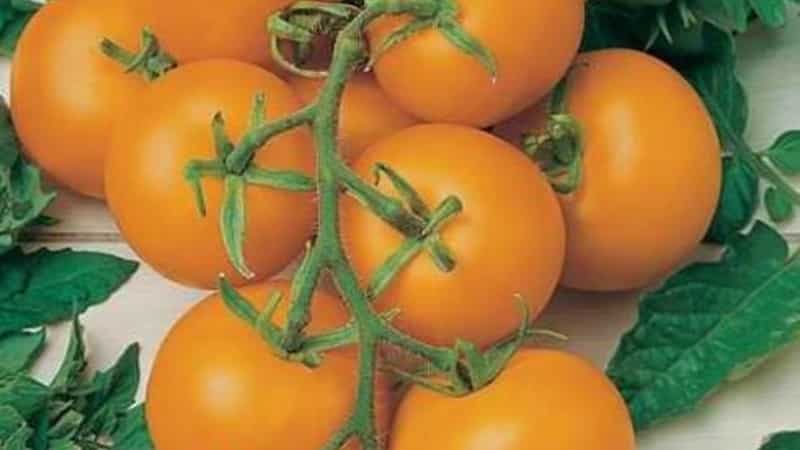
How to grow seedlings
Sowing of seeds begins 2 months before planting seedlings in the ground, pre-preparing them for planting.
Seed preparation
Before sowing, grains are inspected for suitability based on external signs.. They should be without visible damage and not too small. Then they are disinfected in a weak solution of potassium permanganate, where they are placed for 20 minutes.
For germination, planting material is left in aloe juice for 12-18 hours. Aloe juice gives the seeds additional protection from infections and nutrients. As soon as the first sprouts of 2 mm in size appear, the grains can be sown in the ground.
Container and soil
The soil is prepared from garden soil mixed with humus and washed river sand. Add 0.5 liters of ash per bucket of soil to the prepared mixture. Such soil is considered light and fertile, which fully meets the requirements of the Golden Nugget tomato.
The soil mixture is laid out in planting containers, filling them halfway. Subsequently, as the seedlings grow and develop, the remaining soil is added to containers. This intake provides additional nutrients.
You can plant in a common wooden box or in individual containers, for example, plastic and peat cups or paper honeycombs.
Sowing seedlings
Seeds are sown in grooves at least 1.5 cm deep at a distance of 2 cm from each other.. Before sowing, lightly moisten the soil with a spray bottle. After sowing, the containers are covered with film or glass and left in a warm room at a temperature of at least 23˚C.
Read also:
Growing and care
When the first shoots appear, the containers are moved to a well-lit place, for example, on a windowsill.. Daylight hours for seedlings should be at least 16 hours. If there is a lack of natural light, be sure to supplement it with phytolamps.
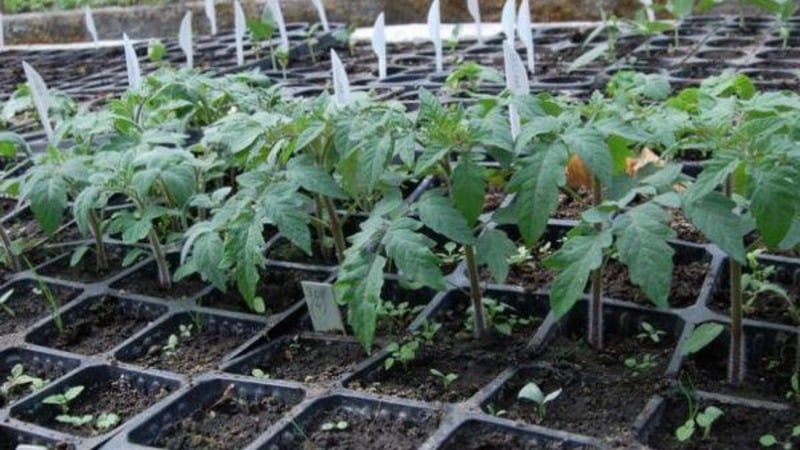
Water as needed with warm, settled water using a shallow watering can., along the edge of the nursery. After watering, the seedlings are loosened superficially without touching the roots.
When 2 true leaves appear, the seedlings are picked, planting them in separate containers or leaving them in a common box at a distance of 10 cm from each other and 10 cm between rows.
2 weeks before transplanting into open ground, seedlings begin to harden. The hardening procedure boils down to keeping the seedlings outdoors for 1-2 hours. This method helps the seedlings quickly adapt to outdoor conditions. Gradually, the time spent on the street is increased to 14 hours.
How to grow tomatoes
After 2 months, the seedlings are ready to be transplanted to a permanent place. At this time, the young bushes look stronger, they have at least 7 true leaves and a fully developed root system.
Landing
It is best to plant in open ground in the evening or in cloudy weather., since the tomato does not like direct sunlight and it will be more difficult for it to adapt to new conditions at an unfavorable moment.
The holes are prepared in advance with a depth of 15-25 cm. Add a little ash to the bottom and fill with water. After planting, the soil is compacted and hilled. After this, the sprouts are left unattended for 5 days.
Tomato care Golden nugget
Regular watering is established as soon as young bushes adapt to new conditions. Always water with warm, settled water at least 2 times a week. On dry days, the number of waterings is increased to 3 times a week.
Reference! From excess moisture, the fruits begin to crack.
Water at the root, without getting on the leaves, to avoid burning the green mass.. The best irrigation option is drip irrigation. To do this, place an ordinary plastic bottle without a bottom next to the roots of the plant. Water is poured into it, and the moisture gradually penetrates to the roots. After each watering, the soil is loosened and hilled up.
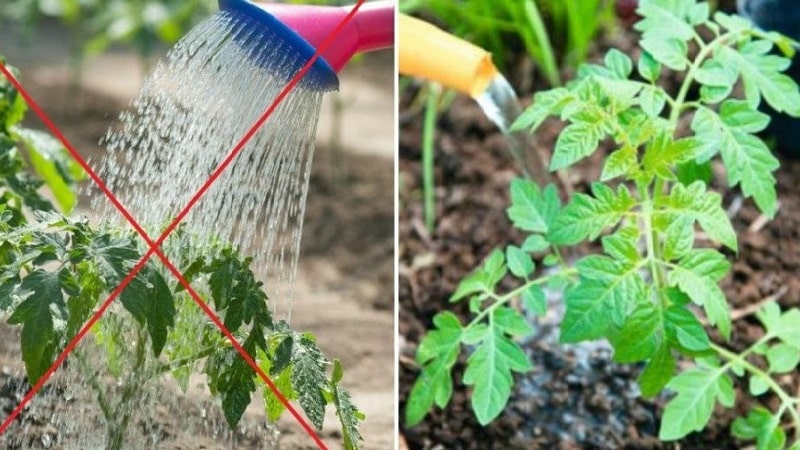
Reference! Loosening the soil improves soil breathability.
Mulching beds with straw or peat retains moisture in the beds, making watering less frequent. Mulching is also a preventive measure in pest control.
Feed at least 3 times per season with a complex of mineral fertilizers or organic matter.. Mullein infusion and bird droppings in a concentration of 1:15 with water are suitable as organic matter.
The first feeding is carried out 2 weeks after transplanting the seedlings. Plants require a second feeding during flowering, and a third feeding during fruit formation.
Features of cultivation and possible difficulties
Tall bushes of the Golden Nugget require mandatory pinching. They are tied to a wooden support or to metal rods, which are installed immediately when planting the bushes in the ground. Many gardeners install trellises, which is considered the most convenient way to garter.
Since the plant is characterized by a constant increase in green mass, there is a need for systematic pinching. Remove unnecessary shoots in the morning. After the procedure, the bushes are treated with a weak solution of potassium permanganate.
The highest fruiting rate of this variety is when growing a bush with 2 stems.
Diseases and pests
The species is resistant to fusarium wilt, tomato bronzing, gray spot, verticillium and tobacco mosaic. But late blight is susceptible to fungal disease. Mandatory preventive measures will help prevent the spread of pathogenic spores. To do this, you need to systematically loosen the beds and remove weeds with roots.
Waterlogging of the soil and elevated air temperatures are favorable factors for the development of fungal infections. Therefore, it is necessary to control the soil moisture level.The lower leaves are removed so that they do not rot from constant contact with wet beds, which also contributes to the spread of the fungus.
If the disease does affect the crop, fungicides will help in the fight against it., for example, "Fitosporin". Copper sulfate, which is sprayed on both the soil and plants, also helps a lot. Copper sulfate is also used as a preventive measure.
Among the pests, beware of the mole cricket and the Colorado potato beetle.. The mole cricket moves underground, disturbing the root system. It is almost impossible to notice it, but strong-smelling herbs such as calendula and marigolds, planted next to the tomatoes, help scare it away from the garden beds.
On a note! The mole cricket is afraid of the smell of garlic, so it is crushed and buried in the beds.
Spraying the bushes with mustard powder helps prevent the Colorado potato beetle.. The beetle itself and its larvae are collected by hand and burned. Regular inspection of bushes helps to protect plants from insect invasion in time.
The nuances of growing in open ground and in a greenhouse
The variety is recommended for cultivation both in open ground and in greenhouse conditions.. To increase the yield, the plant is grown in 2 trunks. In order not to lose part of the harvest, it is recommended to pick off the leaves under each newly formed fruiting cluster. This measure will protect the developing fruits from damage by fungal spores.
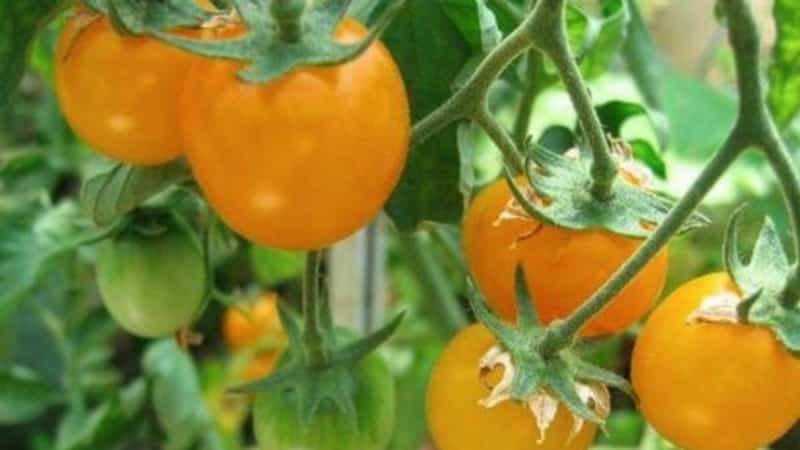
Pinching tall plants is not necessary, they finish themselves after the formation of 9-10 brushes.
To increase the resistance of tomatoes to fungal diseases, they are fed with fertilizers, containing potassium, magnesium and nitrogen salts.
If the crop is planted in a greenhouse, it must be regularly ventilated. Greenhouse plants are often harmed by spider mites, which live only in greenhouse conditions. A regular influx of fresh air destroys the parasite’s usual habitat.
The Golden Nugget variety can be grown on the balcony in large containers. Fruitful branches decorated with golden tomatoes look unusual and decorative. But do not forget about the need to tie up tall bushes.
It can be useful:
How to grow and tie tall tomatoes
Harvesting and application
Ripe vegetables ripen in clusters, which makes their collection much easier.
The purpose is universal: they look great in summer salads, perfectly complementing other vegetables, decorating any assorted dishes, sandwiches and canapés. Yellow vegetables are processed for the production of tomato products: pastes, juices, lecho. They are good to mix when pickling with red tomatoes; jars of colorful vegetables look very appetizing.
Small tomatoes are good for whole-fruit canning, and they not only perfectly retain their taste, but also do not crack during heat treatment.
Tomato pulp is rich in vitamin C, lycopene, beta-carotene. But despite the content of these substances, tomatoes are recognized as hypoallergenic, which allows them to be used for baby and dietary food.
Ripe vegetables are subject to long-term storage and can withstand long-term transportation without loss of appearance and taste.
Advantages and disadvantages
A gold nugget has many positive qualities:
- high resistance to diseases;
- high fruiting rate;
- ease of care;
- possibility of cultivation in garden beds and at home;
- possibility of independent selection of seed material;
- excellent taste of fruits;
- amicable maturation;
- extended fruiting;
- rich in vitamin C;
- versatility in cooking;
- good for baby and diet food;
- long shelf life;
- transportable.
When choosing a variety, you should take into account that it:
- requires a garter;
- requires stepsoning;
- susceptible to late blight.
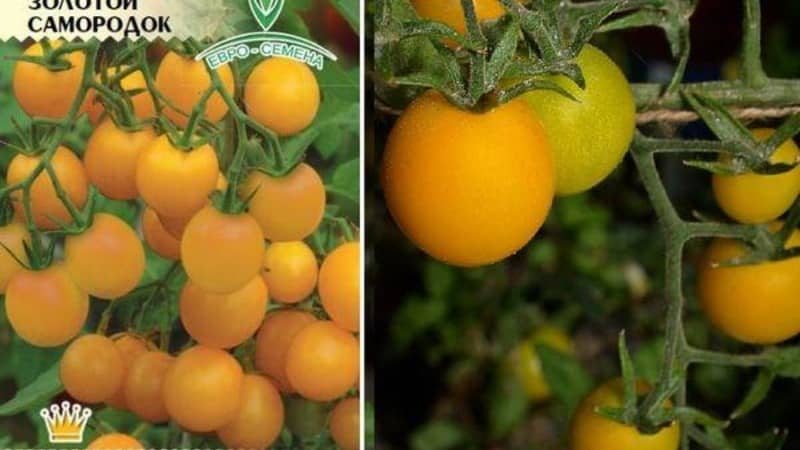
Farmer reviews
Feedback from farmers indicates the reliability of the crop, which decorates many gardens with yellow-golden tomatoes. Here are some opinions from vegetable growers.
Anna, Moscow region: “Such small tomatoes on tall bushes not only look great, but are also extremely tasty. Of course, this requires proper care. But it's not difficult at all. Just don’t forget about tying up bushes and timely feeding.”.
Egor, Tikhoretsk: “The plant had 2 stems. Watered, tied up, fertilized. The harvest turned out to be excellent. It’s enough to eat in the summer and prepare for the winter.”.
Conclusion
Immune to many diseases, high-yielding, easy to care for and with fortified fruits, this tomato variety is a real treasure for all lovers of yellow tomatoes. The ability to grow it on the balcony is another “trick” of the Golden Nugget. A separate bonus for gardeners who decide to grow it is the bright appearance that the fruits retain during any heat treatment.
“Characteristics of fruits Average weight of fruits is 25-50 g”
In the video, when reading the properties from packaging up to 10 grams. Who should Zine believe?